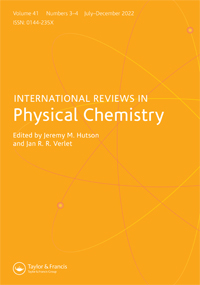The TDDVR approach for molecular photoexcitation, molecule–surface and triatomic reactive scattering processes
IF 2.5
2区 化学
Q3 CHEMISTRY, PHYSICAL
引用次数: 9
Abstract
ABSTRACT The Time Dependent Discrete Variable Representation (TDDVR) method was initiated by Adhikari and Billing considering time dependent Gauss-Hermite basis functions, where all the parameters were assumed to be time dependent. Adhikari et al. had reformulated the TDDVR approach considering the width parameter as time independent, whereas the equation of motion for time dependent parameters (center of wave packet and its momentum) are derived from Dirac-Frenkel variational principle. Such a method is computationally efficient due to its inherent parallelizable nature to perform multistate (electronic) multidimensional (vibrational) quantum dynamics for well-converged results within reasonably fast computation time, where the complexity of the Hamiltonian is not a matter of concern. Its parallel version is computationally efficient as compared to other quantum dynamical method like the multiconfiguration time dependent Hartree (MCTDH). The parallelized version of this method has also been employed to different complex dynamical systems to calculate transition probabilities, tunnelling probabilities, inelastic surface scattering, bi-molecular reactive scattering and photoexcitation. We have also made use of TDDVR methodology successfully to different diatom (H2/D2)-metal surface (Cu/Ni) scattering processes and triatomic reaction dynamics by using 3D time dependent wave packet approach in hyperspherical coordinates to calculate state-to-state reaction probabilities of D+H2 reaction for J=0 case.TDDVR方法用于分子光激发,分子表面和三原子反应散射过程
Adhikari和Billing提出了时间相关离散变量表示(TDDVR)方法,该方法考虑了时间相关的Gauss-Hermite基函数,其中所有参数都假定为时间相关。Adhikari等人考虑宽度参数与时间无关,重新制定了TDDVR方法,而与时间相关的参数(波包中心及其动量)的运动方程是由Dirac-Frenkel变分原理导出的。这种方法的计算效率很高,因为其固有的并行性可以在相当快的计算时间内执行多态(电子)多维(振动)量子动力学以获得良好收敛的结果,其中哈密顿量的复杂性不是一个问题。它的并行版本与其他量子动力学方法(如多配置时间相关哈特里(MCTDH))相比,计算效率很高。该方法的并行化版本还应用于不同的复杂动力系统,计算跃迁概率、隧道概率、非弹性表面散射、双分子反应散射和光激发。我们还利用TDDVR方法成功地对硅藻(H2/D2)-金属表面(Cu/Ni)的不同散射过程和三原子反应动力学进行了研究,在超球坐标下采用三维时变波包法计算了J=0情况下D+H2反应的状态间反应概率。
本文章由计算机程序翻译,如有差异,请以英文原文为准。
求助全文
约1分钟内获得全文
求助全文
来源期刊
CiteScore
14.20
自引率
1.60%
发文量
5
审稿时长
1 months
期刊介绍:
International Reviews in Physical Chemistry publishes review articles describing frontier research areas in physical chemistry. Internationally renowned scientists describe their own research in the wider context of the field. The articles are of interest not only to specialists but also to those wishing to read general and authoritative accounts of recent developments in physical chemistry, chemical physics and theoretical chemistry. The journal appeals to research workers, lecturers and research students alike.

 求助内容:
求助内容: 应助结果提醒方式:
应助结果提醒方式:


